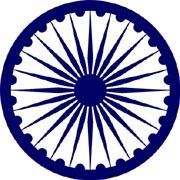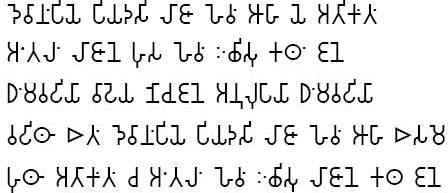'satyam brruyat priyam bruyat, ma bruyat satyam apriyam'. According to the Indian notion, the truthful speech carries with it pleasant, sweet and appealing, so as the adage goes. Devanampriya Priyadarshin was the title bestowed upon Ashoka from the edicts found in the brahmi script. Ashoka - the beloved of the gods. His life's message is ' P R E V E N T I O N O F W A R
When Chanda Ashoka (Ahoka the Fierce) reflected upon the scene of carnage and bloodshed and after effects of the aggressive war waged on Kalinga, it occurred to him, the painful guilt of having slain a vast majority of people in pursuit of winning over an unconquered country. Many other Rulers have also felt the guilt after seeing the devastation and ill-effects of war. But, it was only Ashoka who openly admitted to it and devoted his life to spread of BUDDHISM He took on to Buddhism and reigned upon the vast country of Indian continent that stretched from Afghanistan to Kashmir in the North, uptil the foot of the Himalayas in the east and the Deccan Plateau in the South.
Tradition ascribes to Ashoka the foundation of 2 cities, the first being Srinagara, the capital of Kashmir. He built 500 Buddhist monasteries together with other edifices. The second city is the Devapattana (Deo-Patan) in Nepal and four stupas still standing in the archaic style.
Here's the excerpt from Sid's blog: http://sidshome1.blogspot.com/2006/09/king-devanampiya-piyadasi-and.html
The Ashoka Chakra and the Lion Capital – these symbols of modern India connect us to our glorious past. They arouse in us a sense of pride and grandeur, reminding us of our long and magnificent heritage. Mahatma Gandhi, commenting on the national flag, said, “looking at the wheel some may recall that Prince of Peace, King Ashoka, ruler of an empire, who renounced power. He represents all faiths; he was an embodiment of compassion. … Ashoka’s Chakra represents the eternally revolving Divine Law of Ahimsa.” And according to Jawaharlal Nehru “we have associated with our flag not only this emblem but in a sense the name of Ashoka, one of the most magnificent names in India’s history and the world.” Today every school child in India learns about Emperor Ashoka's righteous rule over a vast empire, and about the Maurya and the Gupta dynasty, now referred to as the Golden Age of India.



Asokan Edict - Delhi Inscription
When Chanda Ashoka (Ahoka the Fierce) reflected upon the scene of carnage and bloodshed and after effects of the aggressive war waged on Kalinga, it occurred to him, the painful guilt of having slain a vast majority of people in pursuit of winning over an unconquered country. Many other Rulers have also felt the guilt after seeing the devastation and ill-effects of war. But, it was only Ashoka who openly admitted to it and devoted his life to spread of BUDDHISM He took on to Buddhism and reigned upon the vast country of Indian continent that stretched from Afghanistan to Kashmir in the North, uptil the foot of the Himalayas in the east and the Deccan Plateau in the South.
Tradition ascribes to Ashoka the foundation of 2 cities, the first being Srinagara, the capital of Kashmir. He built 500 Buddhist monasteries together with other edifices. The second city is the Devapattana (Deo-Patan) in Nepal and four stupas still standing in the archaic style.
Here's the excerpt from Sid's blog: http://sidshome1.blogspot.com/2006/09/king-devanampiya-piyadasi-and.html
The Ashoka Chakra and the Lion Capital – these symbols of modern India connect us to our glorious past. They arouse in us a sense of pride and grandeur, reminding us of our long and magnificent heritage. Mahatma Gandhi, commenting on the national flag, said, “looking at the wheel some may recall that Prince of Peace, King Ashoka, ruler of an empire, who renounced power. He represents all faiths; he was an embodiment of compassion. … Ashoka’s Chakra represents the eternally revolving Divine Law of Ahimsa.” And according to Jawaharlal Nehru “we have associated with our flag not only this emblem but in a sense the name of Ashoka, one of the most magnificent names in India’s history and the world.” Today every school child in India learns about Emperor Ashoka's righteous rule over a vast empire, and about the Maurya and the Gupta dynasty, now referred to as the Golden Age of India.



Asokan Edict - Delhi Inscription
Transliteration
devānaṁpiye piyadasi lājā hevaṁ āhā ye atikaṁtaṁ
aṁtalaṁ lājāne husa hevaṁ ichisu kathaṁ jane
dhaṁmavaḍhiyā vāḍheya nocujane anulupāyā dhaṁmavaḍhiyā
vaḍhithā etaṁ devānaṁpiye piyadasi lājā hevaṁ āhā esame
huthā atākaṁtaṁ ca aṁtalaṁ hevaṁ ichisu lājāne katha jane
aṁtalaṁ lājāne husa hevaṁ ichisu kathaṁ jane
dhaṁmavaḍhiyā vāḍheya nocujane anulupāyā dhaṁmavaḍhiyā
vaḍhithā etaṁ devānaṁpiye piyadasi lājā hevaṁ āhā esame
huthā atākaṁtaṁ ca aṁtalaṁ hevaṁ ichisu lājāne katha jane
Translation
Thus spoke king Devanampiya Piyadasi: "Kings of the olden time have gone to heaven under these very desires. How then among mankind may religion (or growth in grace) be increased? Yea, through the conversion of the humbly-born shall religion increase"